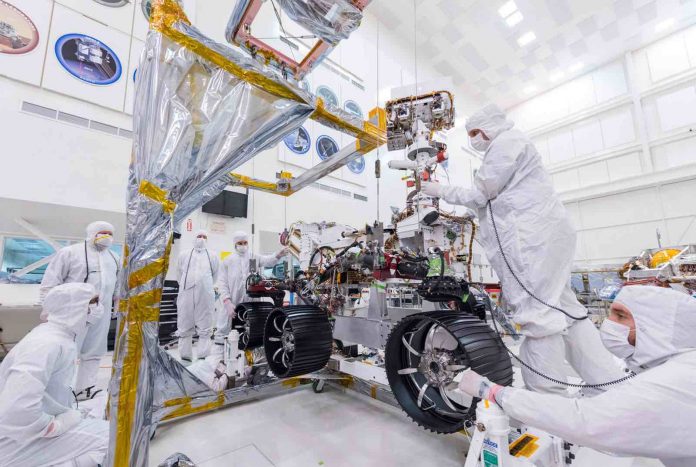Researchers at NASA have pulled the wraps off its Mars 2020 rover after it was relocated from the agency’s Spacecraft Assembly Facility to the Simulator Building located at Jet Propulsion Laboratory (JPL) for being tested. The agency has released a time-lapse video that was taken earlier this month where bunny-suited engineers are seen removing the inner layer of protective antistatic foil on the Mars 2020 rover.
“The Mars 2020 rover will be collecting samples for future return to Earth, so it must meet extraordinary cleanliness measures to avoid the possibility of contaminating Martian samples with terrestrial contaminants,” said Paul Boeder, contamination control lead for Mars 2020 at JPL. “To ensure we maintain cleanliness at all times, we need to keep things clean not only during assembly and testing, but also during the moves between buildings for these activities.”
After removing the first layer of antistatic foil (just prior this time-lapse), the teams used 70% isopropyl alcohol to meticulously wipe down the remaining layer, seen here, along with the trailer carrying the rover. Later that day, the rover was moved into the larger main room of the Simulator Building. In the coming weeks, the rover will enter a massive vacuum chamber for surface thermal testing — a weeklong evaluation of how its instruments, systems and subsystems operate in the frigid, near-vacuum environment it will face on Mars.
JPL is building and will manage operations of the Mars 2020 rover for NASA. The rover will launch on a United Launch Alliance Atlas V rocket in July 2020 from Space Launch Complex 41 at Cape Canaveral Air Force Station. NASA’s Launch Services Program, based at the agency’s Kennedy Space Center in Florida, is responsible for launch management.
When the rover lands at Jezero Crater on Feb. 18, 2021, it will be the first spacecraft in the history of planetary exploration with the ability to accurately retarget its point of touchdown during the landing sequence.
Charged with returning astronauts to the Moon by 2024, NASA’s Artemis lunar exploration plans will establish a sustained human presence on and around the Moon by 2028. We will use what we learn on the Moon to prepare to send astronauts to Mars.
Interested K-12 students in U.S. public, private and home schools can enter the Mars 2020 Name the Rover essay contest. One grand prize winner will name the rover.















